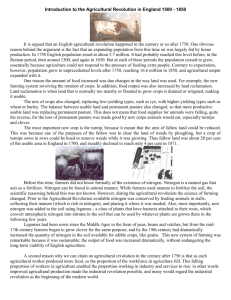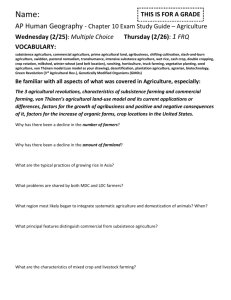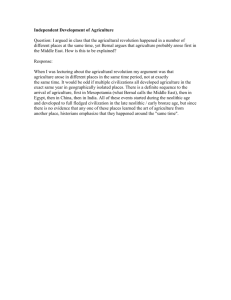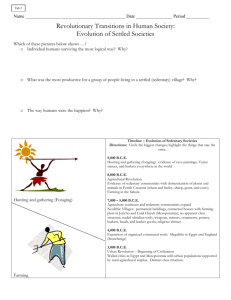Agricultural Revolution in England 1500
advertisement
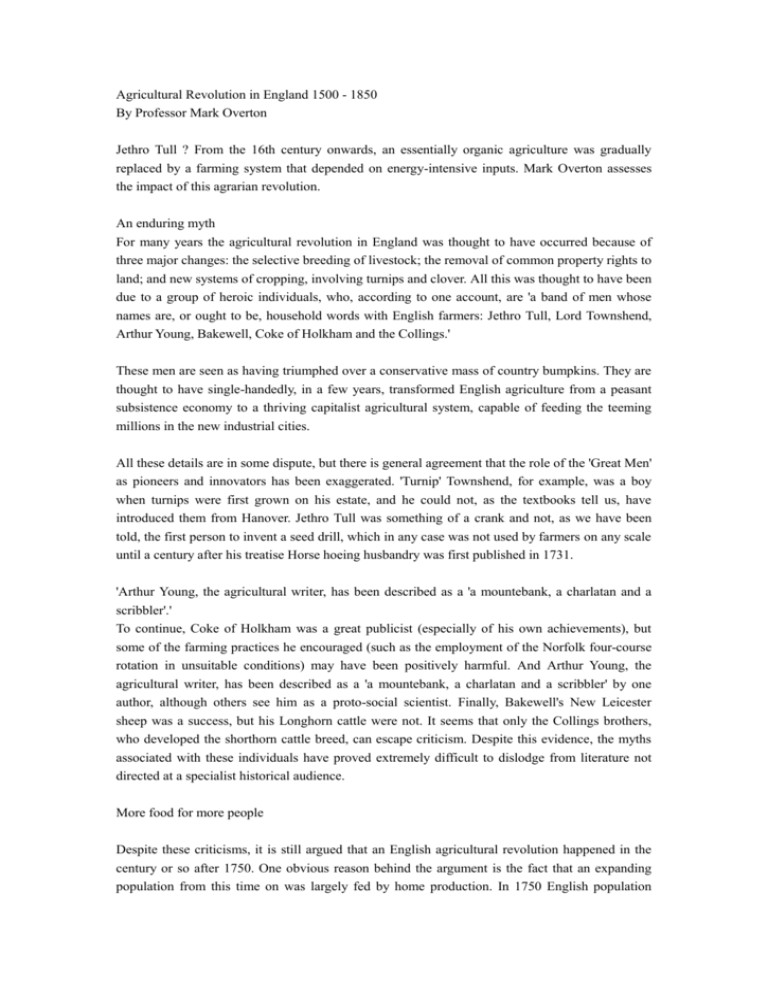
Agricultural Revolution in England 1500 - 1850 By Professor Mark Overton Jethro Tull ? From the 16th century onwards, an essentially organic agriculture was gradually replaced by a farming system that depended on energy-intensive inputs. Mark Overton assesses the impact of this agrarian revolution. An enduring myth For many years the agricultural revolution in England was thought to have occurred because of three major changes: the selective breeding of livestock; the removal of common property rights to land; and new systems of cropping, involving turnips and clover. All this was thought to have been due to a group of heroic individuals, who, according to one account, are 'a band of men whose names are, or ought to be, household words with English farmers: Jethro Tull, Lord Townshend, Arthur Young, Bakewell, Coke of Holkham and the Collings.' These men are seen as having triumphed over a conservative mass of country bumpkins. They are thought to have single-handedly, in a few years, transformed English agriculture from a peasant subsistence economy to a thriving capitalist agricultural system, capable of feeding the teeming millions in the new industrial cities. All these details are in some dispute, but there is general agreement that the role of the 'Great Men' as pioneers and innovators has been exaggerated. 'Turnip' Townshend, for example, was a boy when turnips were first grown on his estate, and he could not, as the textbooks tell us, have introduced them from Hanover. Jethro Tull was something of a crank and not, as we have been told, the first person to invent a seed drill, which in any case was not used by farmers on any scale until a century after his treatise Horse hoeing husbandry was first published in 1731. 'Arthur Young, the agricultural writer, has been described as a 'a mountebank, a charlatan and a scribbler'.' To continue, Coke of Holkham was a great publicist (especially of his own achievements), but some of the farming practices he encouraged (such as the employment of the Norfolk four-course rotation in unsuitable conditions) may have been positively harmful. And Arthur Young, the agricultural writer, has been described as a 'a mountebank, a charlatan and a scribbler' by one author, although others see him as a proto-social scientist. Finally, Bakewell's New Leicester sheep was a success, but his Longhorn cattle were not. It seems that only the Collings brothers, who developed the shorthorn cattle breed, can escape criticism. Despite this evidence, the myths associated with these individuals have proved extremely difficult to dislodge from literature not directed at a specialist historical audience. More food for more people Despite these criticisms, it is still argued that an English agricultural revolution happened in the century or so after 1750. One obvious reason behind the argument is the fact that an expanding population from this time on was largely fed by home production. In 1750 English population stood at about 5.7 million. It had probably reached this level before, in the Roman period, then around 1300, and again in 1650. But at each of these periods the population ceased to grow, essentially because agriculture could not respond to the pressure of feeding extra people. Contrary to expectation, however, population grew to unprecedented levels after 1750, reaching 16.6 million in 1850, and agricultural output expanded with it. 'Low-intensity agricultural system based on fishing and fowling was replaced by a high-intensity system based on arable crops.' One reason output grew was through new farming systems involving the rotation of turnips and clover, although these were part of the general intensification of agricultural production, with more food being produced from the same area of land. Intensity was also increased by land reclamation, especially the draining of the fenlands of eastern England, from the 17th century onwards, when a low-intensity agricultural system based on fishing and fowling was replaced by a high-intensity system based on arable crops. Other examples include the clearing of woodland and the reclamation of upland pastures. This extent of this activity is impossible to quantify, but may have affected some 30 per cent of the agricultural area of England, from the mid-17th to the mid-19th centuries. Crop yields The mix of crops also changed, replacing low-yielding types, such as rye, with higher-yielding types such as wheat or barley. The balance between arable and permanent pasture also changed, so that more productive arable land was replacing permanent pasture. This does not mean that fodder supplies were falling, quite the reverse, for the loss of permanent pasture was made good by new fodder crops, especially turnips and clover, in arable rotations. Not only did these crops result in an increase in fodder yields, but they were also instrumental in the reclamation of many lowland heaths from rough pasture to productive arable farms. The most important new crop in this context is the turnip, because it meant that the area of fallow land could be reduced. This was because one of the purposes of the fallow was to clear the land of weeds by ploughing, but a crop of turnips sown in rows could be hoed to remove weeds while it was growing. Thus fallow land was about 20 per cent of the arable area in England in 1700, and steadily declined to reach only 4 per cent in 1871. One of the earliest pieces of evidence we have, concerning the cultivation of turnips for animal fodder, is the inventory taken for probate purposes, in 1638, of the possessions of a Mr Pope, of Burgh Castle in Suffolk. But turnips were not common until the mid-18th century, and not widespread as part of the new Norfolk four-course rotation until the 19th century. 'Nitrogen...was the 'limiting factor' in determining cereal yields before about 1830.' Cereal yields also increased. Wheat yields increased by about a quarter between 1700 and 1800, and then by about a half between 1800 and 1850, and the most recent research emphasises the early 19th century as the period of crucial change. The key to increasing cereal yields was nitrogen, which we now know was the 'limiting factor' in determining cereal yields before about 1830. Farming systems Southdown sheep with turnips Before this time, farmers did not know formally of the existence of nitrogen, but we can interpret many of their actions in terms of the conservation of existing stocks of nitrogen, and the addition of new nitrogen to the soil. Existing stocks were exploited, for example, by ploughing up permanent pasture to grow cereals. Available nitrogen was conserved by feeding bullocks in stalls, collecting their manure (which is rich in nitrogen), and placing it where it was needed. Also, most importantly, new nitrogen was added to the soil using legumes - a class of plants that have bacteria attached to their roots, which convert atmospheric nitrogen into nitrates in the soil that can be used by whatever plants are grown there in the following few years. 'An essentially organic agriculture was gradually replaced by a farming system that depended on energy-intensive inputs.' Legumes had been sown since the Middle Ages in the form of peas, beans and vetches, but from the mid-17th century farmers began to grow clover, both white and red, for the same purpose, and by the 19th century had dramatically increased the quantity of nitrogen in the soil available for cereal crops. In Norfolk, for example, between 1700 and 1850, the doubling of the area of legumes and a switch to clover tripled the rate of symbiotic nitrogen fixation. This new system of farming was remarkable because it was sustainable; the output of food was increased dramatically, without endangering the long-term viability of English agriculture. But just as a sustainable agriculture had been achieved, the development of chemical fertilisers and other external inputs undermined this sustainability. An essentially organic agriculture was gradually replaced by a farming system that depended on energy-intensive inputs dependent on the exploitation of fossil fuels. More food per worker Feeding sheep on turnips A second reason why we can claim an agricultural revolution in the century after 1750 is that as each agricultural worker produced more food, so the proportion of the workforce in agriculture fell. This falling proportion of workers in agriculture enabled the proportion working in industry and services to rise: in other words improved agricultural production made the industrial revolution possible, and many would regard the industrial revolution as the beginning of the modern world. By 1850 only 22 per cent of the British workforce was in agriculture; the smallest proportion for any country in the world. 'The development of agrarian capitalism in England saw the development of better farm management and more efficiency in using the workforce.' Exactly how those working on the land were able to produce more food remains something of a mystery. More animal power was available to English farmers than to their counterparts elsewhere, and from the 1820s and 30s a wide variety of machinery was developed, which was particularly important for improving the efficiency of the cutting and threshing of grain. The improvement in labour productivity, however, had begun long before this. The key probably lies in the way the English workforce was organised and employed. The development of agrarian capitalism in England, with those involved in agriculture divided into landowners, capitalist tenant farmers and labourers, saw the development of better farm management and more efficiency in using the workforce. Debate about the agricultural revolution in England is still full of controversy. Some historians, particularly those using the techniques of economics to derive indices of output and productivity from prices, completely dismiss the idea of an agricultural revolution after 1750 and argue that the major changes happened earlier. Since no national agricultural statistics were produced until 1866 it is understandable that historians search for techniques that purport to give them the information they want: but it is difficult to avoid the overwhelming mass of evidence from a wide variety of sources that points to the period after 1750 as witnessing an agricultural revolution. Find out more Read on Agricultural Revolution in England: The Transformation of the Agrarian Economy 1500-1850 by Mark Overton (Cambridge University Press, 1996) The Transformation of Rural England: Farming and the Landscape, 1700-1870 by Tom Williamson (Exeter University Press, 2002) Farm Production in England 1700-1914 by ME Turner, JV Beckett and B Afton (Oxford University Press, 2001) Two Hundred Years of British Farm Livestock by Stephen JG Hall and Juliet Clutton-Brock (British Museum [Natural History], 1989) The Agrarian History of England and Wales edited by J Thirsk (Cambridge University Press: vol. IV, 1967; vol. V, 1985; vol. VI, 1989) About the author Mark Overton is Professor of Economic and Social History at the University of Exeter. He has published extensively on the agrarian history of England, including Agricultural Revolution in England-1500-1850, and is now completing a project on production and consumption in English households 1600-1750, to be published by Routledge.
